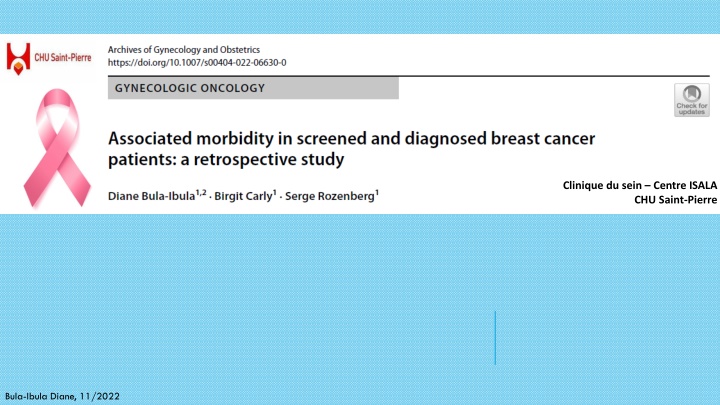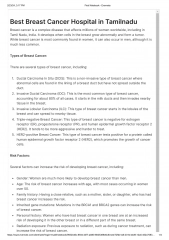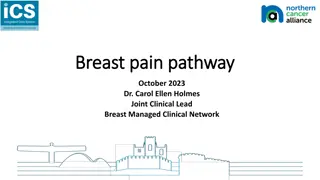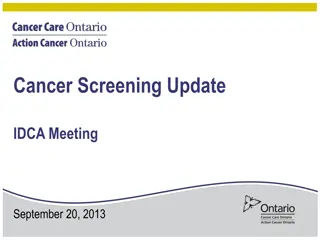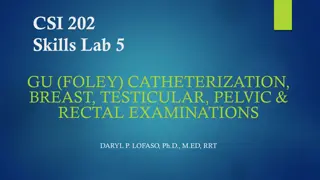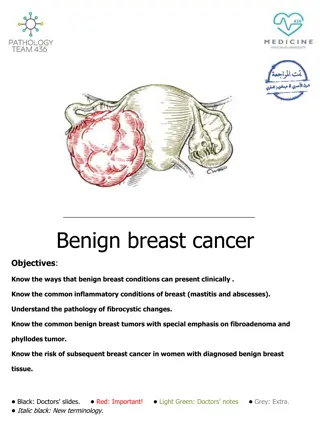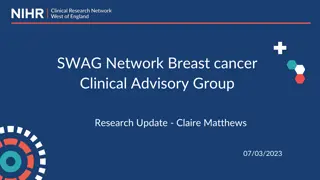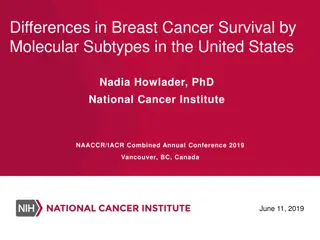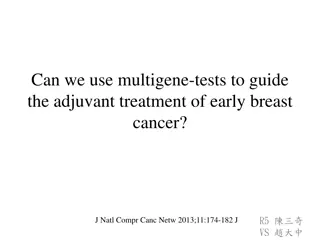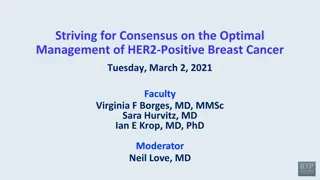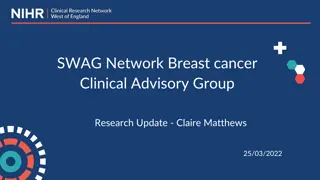Breast Cancer Screening Study
Breast cancer is a significant health concern among women globally, impacting mortality rates. This study evaluates the effectiveness of screening in reducing morbidity levels in comparison to clinically diagnosed cases. The research encompasses patient characteristics, tumor profiles, treatment strategies, and analyses to determine the impact of diagnostic methods on treatment outcomes.
Download Presentation

Please find below an Image/Link to download the presentation.
The content on the website is provided AS IS for your information and personal use only. It may not be sold, licensed, or shared on other websites without obtaining consent from the author.If you encounter any issues during the download, it is possible that the publisher has removed the file from their server.
You are allowed to download the files provided on this website for personal or commercial use, subject to the condition that they are used lawfully. All files are the property of their respective owners.
The content on the website is provided AS IS for your information and personal use only. It may not be sold, licensed, or shared on other websites without obtaining consent from the author.
E N D
Presentation Transcript
Clinique du sein Centre ISALA CHU Saint-Pierre Bula-Ibula Diane, 11/2022
INTRODUCTION Breast cancer: the most frequent cancer in women worldwide mortality: - Treatment improvement - Screening Screening Oeffinger KC, Fontham ETH, Etzioni R, Herzig A, Michaelson JS, Shih Y-CT, et al. Breast Cancer Screening for Women at Average Risk: 2015 Guideline Update From the American Cancer Society. JAMA. 20 oct 2015;314(15):1599-614 Autier P, Boniol M. Mammography screening: A major issue in medicine. Eur J Cancer Oxf Engl 1990. 19 d c 2017;90:34-62
INTRODUCTION Screening Benefit 20% reduction in BC mortality in some studies Harm 30-50% BC overdiagnosis from screening in other studies All breast cancers physical and psychological morbidity
AIM To assess the contribution of screening to morbidity reduction by comparing: Women screened Clinically diagnosed women
MATERIALS AND METHODS Design : retrospective study Recruitment: - 666 with BC from 2010 to 2013 in CHU Saint-Pierre
MATERIALS AND METHODS 1stanalysis: 666 patients in 2 groups: Screened: Clinically diagnosed: - Mammography and/or - - - - - Mass Axillar adenopathy Mammary discharge Pain sonography
MATERIALS AND METHODS 2ndanalysis:
MATERIALS AND METHODS 3rdanalysis Multivariate analysis to examine the effect of diagnostic mode on benefiting: - mastectomy or lumpectomy - axillary dissection or removal of the sentinel lymph node - whether or not to receive chemotherapy
RESULTS 1) Characteristics of patients, tumors and received treatments (Global analysis of screened versus diagnosed patients) Clinically diagnosed tumors (n = 387) Screened tumors (n = 279) Characteristics p Women s characteristics - - Mean age (years-old) [SD] % with personal and/or familial BC histoy 57 [11] 34.6 59 [15] 37.7 0.196 0.436
RESULTS Screened tumors (n = 279) Clinically diagnosed tumors (n = 387) Characteristics P 1) Characteristics of patients,tumors and received treatments (Global analysis of screened versus diagnosed patients) Tumors characteristics - - Mean size (mm) [SD] Grade (%) : 1 2 3 16,46 [15,40] 22,62 [19,27] <0.001 25.4 45.9 19.7 16.0 45.7 29.7 0.001 // // - - % invasive carcinoma % carcinomes in situ 74.2 18.3 87.4 7.2 <0.001 // - - % ductal carcinoma % lobular carcinoma 79.9 18,3 83.5 15,0 0.480 // - - - - - - % node positive % ER positive % PR positive Ki 67 >15% HER2 gene amplification (%) Metastasis (%) 5.7 79.9 74.2 13.6 4.7 2.9 19.7 71.8 66.9 28.7 12.1 14.0 <0.001 0.017 0.043 <0.001 0.005 <0.001
RESULTS 1) Characteristics of patients, tumors and received treatments (Global analysis of screened versus diagnosed patients) Clinically diagnosed tumors (n = 387) Screened tumors (n = 279) Characteristics P Treatments characteristics - Lumpectomies (%) - Mastectomies (%) - Removal sentinel node(%) - Axillary LND (%) - Chemotherapy (%) - Hormonotherapy (%) - Radiotherapy (%) 82.8 15.8 75.6 15.1 20.8 77.1 83.5 59.7 29.5 44.7 35.4 48.3 62.5 74.9 <0.001 <0.001 <0.001 <0.001 <0.001 <0.001 0.008
RESULTS 2) Characteristics of screened and diagnosed tumors in patients without familial or personal BC history, stratifed by age and by mode of presentation 40-49 years old 50-69 years old 70-75 years old Clinically diagnosed tumors (n=38) Clinically diagnosed tumors (n=98) Clinically diagnosed tumors (n=27) Screened tumors (n=37) Screened tumors (n=104) Screened tumors (n=15) Characteristics p p p Stade T (%) : - Tis - T1a-T1b - T1c - T2 - T3 - T4 23.3 33.3 28.3 8.3 1.7 0 7.2 14.5 30.4 37.7 4.3 4.3 18.9 33.7 29.6 7.1 0.6 0.6 5.6 16.8 31.8 24.0 7.3 6.1 0.0 63.0 22.2 7.4 0.0 3.7 10.6 12.8 29.8 31.9 6.4 6.4 <0.001 <0.001 0.001 Stade N (%) : - N0 - N1 - N2 - N3 83.3 1.7 0.0 0.0 72.5 15.9 0.0 1.4 76.3 6.5 0.0 0.0 68.7 16.2 0.6 0.6 81.5 7.4 0.0 0.0 68.1 19.1 0.0 0.0 0.029 0.036 0.359 Stade M (%) : - M1 0.0 10.1 0.040 0.0 3.9 0.027 3.7 12.8 0.436
RESULTS 40-49 years old 50-69 years old 70-75 years old Clinically diagnosed tumors (n=38) Clinically diagnosed tumors (n=98) Clinically diagnosed tumors (n=27) Characteristics Screened tumors (n=37) Screened tumors (n=104) Screened tumors (n=15) p p p Other tumors characteristics: Mean size (mm) [SD] % ductal tumors % lobular tumors % ER positive % PR positive % with Ki 67 >15% HER2 gene amplific (%) Grade (%) : 1 2 3 Metastasis (%) 18.34 [15.29] 91.7 8.3 80.0 73.3 15.0 3.3 18.05 [14.22] 81.6 15.8 72.5 65.2 30.4 14.5 0.703 16.27 [16.13] 77.9 20.2 79.3 75.7 13.6 4.1 22.76 [18.21] 83.7 14.3 72.6 67.0 26.8 11.7 0.001 9,87 [5,64] 73.3 26.7 85.2 74.1 7.4 11.1 25,42 [17,75] 77.8 22.2 66.0 63.8 29.8 2.1 0,002 0,205 0,327 0.158 0.209 0.012 0.003 0,298 0,268 0.146 0.073 0.022 <0.001 0,746 0,746 0.073 0.365 0.020 0.078 32.4 40.5 21.6 1.7 21.1 36.8 34.2 14.5 26.9 45.2 14.4 3.0 15.3 51.0 25.5 12.3 26.7 60.0 6.7 0.0 25.9 37.0 22.2 17.0 0.363 0.038 0.302 0.009 0.003 0.023
RESULTS 40-49 years old 50-69 years old 70-75 years old Characteristics Clinically diagnosed tumors (n=38) Clinically diagnosed tumors (n=98) Clinically diagnosed tumors (n=27) Screened tumors (n=37) Screened tumors (n=104) Screened tumors (n=15) p p p Treatments characteristics: - Lumpectomies (%) - Mastectomies (%) - Removal SNL node (%) - Axillary LND (%) - Chemotherapy (%) - Hormonotherapy (%) 85.0 13.3 75.0 13.3 31.6 76.7 72.5 23.2 47.8 42.0 65.2 53.6 0.085 0.151 0.002 <0.001 <0.001 0.016 81.7 17.8 75.1 16.0 18.3 79.3 63.1 32.4 48.3 38.8 49.7 65.9 <0.001 0.002 <0.001 <0.001 <0.001 0.005 92.6 7.4 81.5 11.1 18.5 77.8 57.4 25.5 52.2 17.4 27.7 57.4 0.001 0.055 0.012 0.469 0.378 0.078
RESULTS 3) Multivariate analysis Lumpectomy vs mastectomy Age groups According to the mode of BC detection (screened or clinically diagnosed) p OR (IC 95%) All <0.001 2.61 (1.72-3.95) 40-49 y-o 0.454 50-69 y-o 0.002 2.63 (1.53-4.54) 70-75 y-o 0.132
RESULTS 3) Multivariate analysis SNL node removal vs Axillary LND Age groups According to the mode of BC detection (screened or clinically diagnosed) p OR (IC 95%) All <0.001 4.46 (2.88-6.91) 40-49 y-o 0.004 4.18 (1.56-11.17) 50-69 y-o <0.001 4.64 (2.62-8.21) 70-75 y-o 0.085
RESULTS 3) Multivariate analysis Chemotherapy vs no chemotherapy Age groups According to the mode of BC detection (screened or clinically diagnosed) p OR (IC 95%) All <0.001 4.79 (3.19-7.18) 40-49 y-o <0.001 4.47 (1.97-10.15) 50-69 y-o <0.001 5.27 (3.07-9.04) 70-75 y-o 0.148
DISCUSSION Several studies have shown that screened tumors: - smaller - Earlier stages - lower grade + of our study: takes into account the history of breast cancer 1 in 3 + patients had a family and/or personal history of breast cancer Barth RJ, Gibson GR, Carney PA, Mott LA, Becher RD, Poplack SP. Detection of breast cancer on screening mammography allows patients to be treated with less-toxic therapy. AJR Am J Roentgenol. janv 2005;184(1):324-9. Cowan WK, Kelly P, Sawan A, Cunliffe WJ, Henry L, Higgs MJ, et al. The pathological and biological nature of screen-detected breast carcinomas: a morphological and immunohistochemical study. J Pathol. mai 1997;182(1):29-35. Spillane AJ, Kennedy CW, Gillett DJ, Carmalt HL, Janu NC, Rickard MT, et al. Screen-detected breast cancer compared to symptomatic presentation: an analysis of surgical treatment and end-points of effective mammographic screening. ANZ J Surg. juill 2001;71(7):398-402.
DISCUSSION Women 40-49 years old No fewer mastectomies for screened tumours than for diagnosed tumours 4x times more likely not to receive chemotherapy 4x times more likely not to have an axillary dissection
DISCUSSION Women 50-69 years old -Tumors screened: 81.7% lumpectomies -Clinically diagnosed tumors: 63.1% lumpectomies -5x more likely to be treated with chemotherapy if clinically diagnosed (OR: 5.27). - => ES: neurotoxicity, cardiomyopathy, increased thromboembolic risk, etc. Azim HA, de Azambuja E, Colozza M, Bines J, Piccart MJ. Long-term toxic effects of adjuvant chemotherapy in breast cancer. Ann Oncol. 1 sept 2011;22(9):1939-47. Cameron AC, Touyz RM, Lang NN. Vascular Complications of Cancer Chemotherapy. Can J Cardiol. juill 2016;32(7):852-62.
DISCUSSION Women 70-75 years old -No difference in treatment between screened women and clinically diagnosed women
DISCUSSION Informed choice Advantages and benefits sometimes not enough Inform about the extent of these effects
DISCUSSION Limitations of the study - No separation between opportunistic and systematic screening - Cancers of undifferentiated intervals from other cancers diagnosed - No information on other factors such as HRT intake, BMI, breast density.
CONCLUSION o Overdiagnosed BC: No marker to date to identify them and the rest of the tumors are evolving o Screening: smaller, less agressive tumors Less mutilating treatments Lower morbidity Inform patients about overdiagnosis, its uncertainty but also about the benefits on morbidity conferred on them by screening
FOR THE FUTURE Taking action: - Before screening By selecting the women to be screened on the basis of factors other than age - After screening By detecting tumors at risk of being overdiagnosed Our Projects: MyPeBS Association of European Cancer Leagues ECL [Internet]. [cit 13 mai 2018]. Disponible sur: https://www.europeancancerleagues.org/our-projects- mypebs/ Groen EJ, Elshof LE, Visser LL, Rutgers EJT, Winter-Warnars HAO, Lips EH, et al. Finding the balance between over- and under-treatment of ductal carcinoma in situ (DCIS). Breast Edinb Scotl. f vr 2017;31:274-83.
Bibliographie: 1. Oefnger KC, Fontham ETH, Etzioni R, Herzig A, Michaelson JS, Shih Y-CT et al (2015) Breast cancer screening for women at average risk: 2015 guideline update from the American cancer society. JAMA. 314(15):1599 614 2. Autier P, Boniol M (2017) Mammography screening: A major issue in medicine. Eur J Cancer (Oxf Engl 1990). 90:34 62 3. Depypere H, Desreux J, P rez-L pez FR, Ceausu I, Erel CT, Lambrinoudaki I, Schenck-Gustafsson K, van der Schouw YT, Simoncini T, Tremollieres F, Rees M (2014) EMAS EMAS position statement: individualized breast cancer screening versus population-based mammography screening programmes. Maturitas 79(4):481 486. https://doi.org/10.1016/j.maturitas.2014.09.002 (Epub 2014 Sep 16PMID: 25277123) 4. Sultova E, Westphalen CB, Jung A et al (2021) NGS-guided precision oncology in metastatic breast and gynecological cancer: frst experiences at the CCC Munich LMU. Arch Gynecol Obstet 303(5):1331 1345 5. Marmot MG, Altman DG, Cameron DA, Dewar JA, Thompson SG, Wilcox M (2013) The benefts and harms of breast cancer screening: an independent review. Br J Cancer. 108(11):2205 40 6. G tzsche PC, J rgensen KJ (2013) Screening for breast cancer with mammography. Cochrane Database Syst Rev. https://doi.org/ 10.1002/14651858.CD001877.pub5 7. Bleyer A, Welch HG (2012) Efect of three decades of screening mammography on breast-cancer incidence. N Engl J Med. 367(21):1998 2005 8. Leung JWT (2005) Screening mammography reduces morbidity of breast cancer treatment. AJR Am J Roentgenol 184(5):1508 1509 9. Paesmans M, Ameye L, Moreau M, Rozenberg S (2010) Breast cancer screening in the older woman: an efective way to reduce mortality? Maturitas 66(3):263 267. https://doi.org/10.1016/j. maturitas.2010.03.016 (Epub 2010 May 6PMID: 20451335) 10. Brennan M, Houssami N (2016) Discussing the benefts and harms of screening mammography. Maturitas 92:150 153. https://doi. org/10.1016/j.maturitas.2016.08.003 (Epub 2016 Aug 11 PMID: 27621253) 11. Independent UK Panel on Breast Cancer Screening (2012) The benefts and harms of breast cancer screening: an independent review. Lancet 380(9855):1778 1786. https://doi.org/10.1016/ S0140-6736(12)61611-0 (Epub 2012 Oct 30 PMID: 23117178) 12. Barth RJ, Gibson GR, Carney PA, Mott LA, Becher RD, Poplack SP (2005) Detection of breast cancer on screening mammography allows patients to be treated with less-toxic therapy. AJR Am J Roentgenol 184(1):324 329 13. Cowan WK, Kelly P, Sawan A, Cunlife WJ, Henry L, Higgs MJ et al (1997) The pathological and biological nature of screendetected breast carcinomas: a morphological and immunohistochemical study. J Pathol 182(1):29 35 14. Spillane AJ, Kennedy CW, Gillett DJ, Carmalt HL, Janu NC, Rickard MT et al (2001) Screen-detected breast cancer compared to symptomatic presentation: an analysis of surgical treatment and end-points of efective mammographic screening. ANZ J Surg 71(7):398 402 15. Chuwa EWL, Yeo AWY, Koong HN, Wong CY, Yong WS, Tan PH et al (2009) Early detection of breast cancer through population-based mammographic screening in Asian women: a comparison study between screen-detected and symptomatic breast cancers. Breast J 15(2):133 139 16. Taubenhansl C, Ortmann O, Gerken M, Inwald EC, Klinkhammer-Schalke M (2020) Guideline-concordant chemotherapy in patients with hormone receptor-positive and node-positive, early breast cancer leads to better overall and metastases-free survival with limited beneft in elderly patients. Arch Gynecol Obstet 301(2):573 583 17. Azim HA, de Azambuja E, Colozza M, Bines J, Piccart MJ (2011) Long-term toxic efects of adjuvant chemotherapy in breast cancer. Ann Oncol. 22(9):1939 47 18. Cameron AC, Touyz RM, Lang NN (2016) Vascular complications of cancer chemotherapy. Can J Cardiol 32(7):852 862
19. Swenson KK, Nissen MJ, Ceronsky C, Swenson L, Lee MW, Tuttle TM (2002) Comparison of side efects between sentinel lymph node and axillary lymph node dissection for breast cancer. Ann Surg Oncol 9(8):745 753 20. Brar P, Jain S, Singh I (2011) Complications of axillary lymph node dissection in treatment of early breast cancer: a comparison of MRM and BCS. Indian J Surg Oncol 2(2):126 132 21. Shieh Y, Eklund M, Sawaya GF, Black WC, Kramer BS, Esserman LJ (2016) Population-based screening for cancer: hope and hype. Nat Rev Clin Oncol 13(9):550 565 22. McWilliams L, Woof VG, Donnelly LS et al (2020) Risk stratifed breast cancer screening: UK healthcare policy decision-making stakeholders views on a low-risk breast screening pathway. BMC Cancer 20:680 23. Delaloge S, Giorgi Rossi P, Guindy M, Gilbert F, Burrion JB et al (2022) Abstract OT2 10 02: mypebs: an international randomized study comparing personalized, risk-stratifed to standard breast cancer screening in women aged 40 70. Cancer Res 82:OT2-10 02 24. Nelson HD, Tyne K, Naik A et al (2009) Screening for breast cancer: an update for the U.S. preventive services task force. Ann Intern Med. 151(10):727-37-W237-42 25. Brouckaert O, Schoneveld A, Truyers C, Kellen E, Van Ongeval C, Vergote I et al (2013) Breast cancer phenotype, nodal status and palpability may be useful in the detection of overdiagnosed screening-detected breast cancers. Ann Oncol Of J Eur Soc Med Oncol. 24(7):1847 52 26. Dawson SJ, Dufy SW, Blows FM, Driver KE, Provenzano E, LeQuesne J et al (2019) Molecular characteristics of screendetected vs symptomatic breast cancers and their impact on survival. Br J Cancer. 101(8):1338 44 27. L berg M, Lousdal ML, Bretthauer M, Kalager M (2015) Benefts and harms of mammography screening. Breast Cancer Res BCR [Intenet]. https://doi.org/10.1186/s13058-015-0525-z 28. Heinig M, Schwarz S, Haug U (2021) Self-selection for mammography screening according to use of hormone replacement therapy: a systematic literature review. Cancer Epidemiol. https://doi. org/10.1016/j.canep.2020.101812 (Epub 2021 Feb 16. PMID: 33608235) 29. Baird J, Yogeswaran G, Oni G, Wilson EE (2021) What can be done to encourage women from Black, Asian and minority ethnic backgrounds to attend breast screening? A qualitative synthesis of barriers and facilitators. Public Health 190:152 159. https:// doi.org/10.1016/j.puhe.2020.10.013 (Epub 2021 Jan 6 PMID: 33419526) 30. Bakker MF, de Lange SV, Pijnappel RM, Mann RM, Peeters PHM, DENSE Trial Study Group et al (2019) Supplemental MRI screening for women with extremely dense breast tissue. N Engl J Med. 381(22):2091 2102. https://doi.org/10.1056/NEJMoa1903 986 (PMID: 31774954) 31. Desreux J, Bleret V, Lifrange E (2012) Should we individualize breast cancer screening? Maturitas 73(3):202 205 32. https://www.bruprev.be/fr/le-depistage-du-cancer-du-sein/ le-cancer-du-sein 33. https://ccref.org/pdf/Mammotest_broch_jan12_HR.pdf
